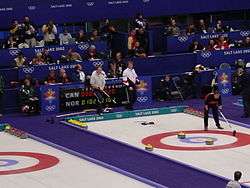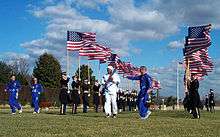2002 Winter Olympics
|
The emblem combines a snow crystal and a sun rising over a mountain. The yellow, orange, and blue colors represent the varied Utah landscape. | |||
| Host city | Salt Lake City, Utah, United States | ||
|---|---|---|---|
| Motto | Light The Fire Within | ||
| Nations participating | 78[1] | ||
| Athletes participating | 2,399 (1,513 men, 886 women)[2] | ||
| Events | 78 in 7 sports (15 disciplines) | ||
| Opening ceremony | February 8 | ||
| Closing ceremony | February 24 | ||
| Officially opened by | President George W. Bush | ||
| Athlete's Oath | Jim Shea | ||
| Judge's Oath | Allen Church | ||
| Olympic Torch | Members of the 1980 USA hockey team, led by team captain Mike Eruzione | ||
| Stadium | Rice-Eccles Stadium | ||
| Winter: | |||
| |||
| Summer: | |||
| |||
 |
"Call of the Champions"
composed by John Williams for the 2002 Winter Olympics in Salt Lake City. Performed by the Mormon Tabernacle Choir and the Utah Symphony Orchestra. The choir sings the Olympic motto "Citius, Altius, Fortius" which is Latin for "Faster, Higher, Stronger."[3] |
| Problems playing this file? See media help. | |
| |
|---|
The 2002 Winter Olympics, officially the XIX Olympic Winter Games (French: Les XIXes Jeux olympiques d'hiver) and commonly known as Salt Lake 2002, were a winter multi-sport event that was celebrated in February 2002 in and around Salt Lake City, United States. Approximately 2,400 athletes from 78 nations participated in 78 events in fifteen disciplines, held throughout 165 sporting sessions. The 2002 Winter Olympics and the 2002 Paralympic Games were both organized by the Salt Lake Organizing Committee (SLOC).[4] Utah became the fifth state in the United States to host the Olympic Games, and the 2002 Winter Olympics are the most recent games to be held in the United States.
The opening ceremony was held on February 8, 2002, and sporting competitions were held up until the closing ceremony on February 24, 2002.[4] Production for both ceremonies was designed by Seven Nielsen, and music for both ceremonies was directed by Mark Watters.[5] Salt Lake City became the most populous area ever to have hosted the Winter Olympics, although the two subsequent host cities' populations were larger.[6] Following a trend, the 2002 Olympic Winter Games were also larger than all prior Winter Games, with 10 more events than the 1998 Winter Olympics in Nagano, Japan.[7]
The Salt Lake Games faced a bribery scandal and some local opposition during the bid, as well as some sporting and refereeing controversies during the competitions. Nevertheless, from sporting and business standpoints, this was one of the most successful Winter Olympiads in history; records were set in both the broadcasting and marketing programs. Over 2 billion viewers watched more than 13 billion viewer-hours.[8] The Games were also financially successful raising more money with fewer sponsors than any prior Olympic Games, which left SLOC with a surplus of $40 million. The surplus was used to create the Utah Athletic Foundation, which maintains and operates many of the remaining Olympic venues.[8] U.S. Federal subsidies amounted to $1.3 billion.[9]
Host city selection




Salt Lake City was chosen over Québec City, Canada, Sion, Switzerland, and Östersund, Sweden, on June 16, 1995, at the 104th IOC Session in Budapest, Hungary.[10] Salt Lake City had previously come in second during the bids for the 1998 Winter Olympics, awarded to Nagano, Japan, and had offered to be the provisional host of the 1976 Winter Olympics when the original host, Denver, Colorado, withdrew. The 1976 Winter Olympics were ultimately awarded to Innsbruck, Austria.
| 2002 Winter Olympics bidding result[11] | |||||
|---|---|---|---|---|---|
| City | Country | Round 1 | |||
| Salt Lake City | 54 | ||||
| Östersund | 14 | ||||
| Sion | 14 | ||||
| Québec City | 7 | ||||
Venues
Competitive venues
| Venue | Events | Gross capacity | Ref. |
|---|---|---|---|
| Deer Valley | Alpine skiing (slalom), freestyle skiing | 13,400 | [12] |
| E Center | Ice hockey | 10,500 | [13] |
| Park City Mountain Resort | Alpine skiing (giant slalom), snowboarding | 16,000 | [14] |
| Peaks Ice Arena | Ice hockey | 8,400 | [15] |
| Salt Lake Ice Center1 | Figure skating, short track speed skating | 17,500 | [13] |
| Snowbasin | Alpine skiing (combined, downhill, super-G) | 22,500 | [16] |
| Soldier Hollow | Biathlon, cross-country skiing, Nordic combined (cross-country skiing portion) | 15,200 | [17] |
| The Ice Sheet at Ogden | Curling | 2,000 | [18] |
| Utah Olympic Oval | Speed skating | 5,236 | [19] |
| Utah Olympic Park (bobsleigh, luge, and skeleton track) | Bobsleigh, luge, skeleton, Nordic combined (ski jumping portion), ski jumping | 18,100 (ski jumping) 15,000 (sliding track) | [20] |
1Because of the no-commercialization policy of the Olympics, the Delta Center, now the Vivint Smart Home Arena, was labeled as the "Salt Lake Ice Center", causing some confusion for visitors.
Non-competitive venues
| Venue | Events/purpose | Gross capacity | Ref. |
|---|---|---|---|
| Main Media Center | International Broadcast Center & Main Press Center | ||
| 2002 Olympic Medals Plaza | Olympic medal presentations & Olympic Celebration Series concerts | 20,000 | [21] |
| 2002 Olympic Village | Olympic Village & Olympic Family Hotel | ||
| Park City Main Street | Main Street celebration area, Park City Technical Center, NBC broadcast center, sponsor showcases | [22] | |
| Rice-Eccles Olympic Stadium | Opening & closing ceremonies | ≈50,000 | [23] |
| Salt Lake Olympic Square | Olympic Medals Plaza, Salt Lake Ice Center, Olympic Superstore, sponsor showcases | [24] |
Cost and cost overrun
The Oxford Olympics Study established the outturn cost of the Salt Lake City 2002 Winter Olympics at USD 2.5 billion in 2015-dollars and cost overrun at 24% in real terms.[25] This includes sports-related costs only, that is, (i) operational costs incurred by the organizing committee for the purpose of staging the Games, e.g., expenditures for technology, transportation, workforce, administration, security, catering, ceremonies, and medical services, and (ii) direct capital costs incurred by the host city and country or private investors to build, e.g., the competition venues, the Olympic village, international broadcast center, and media and press center, which are required to host the Games. Indirect capital costs are not included, such as for road, rail, or airport infrastructure, or for hotel upgrades or other business investment incurred in preparation for the Games but not directly related to staging the Games. The cost and cost overrun for Salt Lake City 2002 compares with costs of USD 2.5 billion and a cost overrun of 13% for Vancouver 2010, and costs of USD 21.9 billion and a cost overrun of 289% for Sochi 2014, the latter being the most costly Olympics to date. Average cost for Winter Games since 1960 is USD 3.1 billion, average cost overrun is 142%.
Participating nations
A total 78[1] National Olympic Committees sent athletes to the Salt Lake City games. Cameroon, Hong Kong (China), Nepal, Tajikistan, and Thailand participated in their first Winter Olympic Games.
Sports
There were 78 events contested in 7 sports (15 disciplines).
-
 Alpine skiing (10)
Alpine skiing (10) -
 Biathlon (8)
Biathlon (8) -
 Bobsleigh (3)
Bobsleigh (3) -
 Cross-country skiing (12)
Cross-country skiing (12) -
 Curling (2)
Curling (2) -
 Figure skating (4)
Figure skating (4) -
 Freestyle skiing (4)
Freestyle skiing (4) -
 Ice hockey (2)
Ice hockey (2) -
 Luge (3)
Luge (3) -
 Nordic combined (3)
Nordic combined (3) -
 Short track speed skating (8)
Short track speed skating (8) -
 Skeleton (2)
Skeleton (2) -
 Ski jumping (3)
Ski jumping (3) -
 Snowboarding (4)
Snowboarding (4) -
 Speed skating (10)
Speed skating (10)
Calendar



In the following calendar for the 2002 Winter Olympic Games, each blue box represents an event competition, such as a qualification round, on that day. The yellow boxes represent days during which medal-awarding finals for a sport are held. The number in each box represents the number of finals that were contested on that day.[27]
- All dates are in Mountain Standard Time (UTC−7)
| OC | Opening ceremony | ● | Event competitions | 1 | Event finals | EG | Exhibition gala | CC | Closing ceremony |
| February | 8th Fri |
9th Sat |
10th Sun |
11th Mon |
12th Tue |
13th Wed |
14th Thu |
15th Fri |
16th Sat |
17th Sun |
18th Mon |
19th Tue |
20th Wed |
21st Thu |
22nd Fri |
23rd Sat |
24th Sun |
Events | |
|---|---|---|---|---|---|---|---|---|---|---|---|---|---|---|---|---|---|---|---|
| OC | CC | ||||||||||||||||||
| |
1 | 1 | 1 | 1 | 1 | 1 | 1 | 1 | 1 | 1 | 10 | ||||||||
| |
2 | 2 | 2 | 1 | 1 | 8 | |||||||||||||
| |
● | 1 | 1 | ● | 1 | 3 | |||||||||||||
| |
2 | 2 | 1 | 1 | 1 | 2 | 1 | 1 | 1 | 12 | |||||||||
| |
● | ● | ● | ● | ● | ● | ● | ● | ● | ● | 1 | 1 | 2 | ||||||
| |
● | 1 | ● | 1 | ● | ● | 1 | ● | 1 | EG | 4 | ||||||||
| |
1 | 1 | 1 | 1 | 4 | ||||||||||||||
| |
● | ● | ● | ● | ● | ● | ● | ● | ● | ● | ● | ● | 1 | ● | ● | 1 | 2 | ||
| |
● | 1 | ● | 1 | 1 | 3 | |||||||||||||
| |
● | 1 | ● | 1 | ● | 1 | 3 | ||||||||||||
| |
1 | 2 | 2 | 3 | 8 | ||||||||||||||
| |
2 | 2 | |||||||||||||||||
| |
● | 1 | ● | 1 | 1 | 3 | |||||||||||||
| |
1 | 1 | ● | 2 | 4 | ||||||||||||||
| |
1 | 1 | ● | 1 | ● | 1 | 1 | 1 | 1 | 1 | 1 | 1 | 10 | ||||||
| Total events | 4 | 5 | 6 | 4 | 6 | 4 | 5 | 6 | 4 | 4 | 5 | 7 | 5 | 4 | 7 | 2 | 78 | ||
| Cumulative total | 4 | 9 | 15 | 19 | 25 | 29 | 34 | 40 | 44 | 48 | 53 | 60 | 65 | 69 | 76 | 78 | |||
| February | 8th Fri |
9th Sat |
10th Sun |
11th Mon |
12th Tue |
13th Wed |
14th Thu |
15th Fri |
16th Sat |
17th Sun |
18th Mon |
19th Tue |
20th Wed |
21st Thu |
22nd Fri |
23rd Sat |
24th Sun |
Events | |
Medal table


Host country (United States)
To sort this table by nation, total medal count, or any other column, click on the ![]() icon next to the column title.
icon next to the column title.
| Rank | Nation | Gold | Silver | Bronze | Total |
|---|---|---|---|---|---|
| 1 | | 13 | 5 | 7 | 25 |
| 2 | | 12 | 16 | 8 | 36 |
| 3 | | 10 | 13 | 11 | 34 |
| 4 | | 7 | 3 | 7 | 17 |
| 5 | | 5 | 4 | 4 | 13 |
| 6 | | 4 | 5 | 2 | 11 |
| 7 | | 4 | 4 | 5 | 13 |
| 8 | | 4 | 2 | 1 | 7 |
| 9 | | 3 | 5 | 0 | 8 |
| 10 | | 3 | 4 | 10 | 17 |
Records
Several medals records were set and/or tied. They included (bold-face indicates broken during the Vancouver Olympics):
- Norway tied the Soviet Union at the 1976 Winter Olympics for most gold medals at a Winter Olympics, with 13.[28]
- Germany set a record for most total medals at a Winter Olympics, with 36.[29]
- The following records the United States set and/or tied:
- Most gold medals at a home Winter Olympics, with 10, tying Norway at the 1994 Winter Olympics.[28]
- Most total medals at a home Winter Olympics, with 34.
Highlights


- The opening ceremonies included Grammy Award-winning artist LeAnn Rimes singing "Light the Fire Within", the official song of the 2002 Olympics.
- The Grammy Award-winning Mormon Tabernacle Choir performed the "Star-Spangled Banner", national anthem of the United States, for the opening ceremonies.
- John Williams composed a five-minute work for orchestra and chorus, "Call of the Champions", that served as the official theme of the 2002 Winter Olympics, his first for a Winter Olympiad. It was performed by the Utah Symphony Orchestra and featured the Mormon Tabernacle Choir and the Madeleine Choir School singing the official motto of the Olympic Games "Citius, Altius, Fortius" (Faster, Higher, Stronger). The premiere of the work at the opening ceremonies also corresponded with John Williams's 70th birthday. The work is featured on the CD American Journey, and also on the Choir's recording Spirit of America.
- There were also signs of remembrance of September 11, 2001, being the first Olympics since then. They included the flag that flew at Ground Zero, NYPD officer Daniel Rodríguez singing "God Bless America", and honor guards of NYPD and FDNY members.
- Along with the flag that flew at the World Trade Center site, the Challenger flag was also carried into the stadium.
- The opening segment of the opening ceremony celebrated all previous hosts of the Olympic Winter Games.
- The Olympic Flame was lit by the members of the Gold Medal-winning US Hockey Team of the 1980 Winter Olympics in Lake Placid, New York, which was the previous time the Winter Olympics were in the US. (See picture at right)
- These Olympics marked the first time a President of the United States opened an Olympic Winter Games held in the United States, although previous Presidents Franklin Roosevelt and Richard Nixon had opened the 1932 Winter Olympics and the 1960 Winter Olympics in their roles as Governor of New York and Vice President of the United States, respectively.
- These were the first Games to be presided over by IOC president Jacques Rogge.
- Competition highlights included biathlete Ole Einar Bjørndalen of Norway, winning gold in all four men's events (10 k, 12.5 k, 20 k, 4 x 7.5 relay), Nordic combined athlete Samppa Lajunen of Finland winning three gold medals, Simon Ammann of Switzerland taking the double in ski jumping. In alpine skiing, Janica Kostelić won three golds and a silver (the first Winter Olympic medals ever for an athlete from Croatia and the first three-gold performance by a female), while Kjetil André Aamodt of Norway earned his second and third career golds, setting up both athletes to beat the sport's record with their fourth golds earned at the next Winter Olympics near Turin (Aamodt also set the overall medal record in the sport with 8).
- Skeleton returned as a medal sport in the 2002 Games for the first time since 1948.
- Ireland reached its best ever position and came close to winning its first winter medal when Clifton Wrottesley (Clifton Hugh Lancelot de Verdon Wrottesley, 6th Baron Wrottesley) finished fourth in the men's skeleton event.
- The Women's Bobsled Event had its debut at the 2002 Games after several years of World Cup competition.
- A feature of these Games was the emergence of the extreme sports, such as snowboarding, moguls and aerials, which appeared in previous Olympic Winter Games but have captured greater public attention in recent years.
- The United States completed a remarkable sweep of the podium in men's halfpipe snowboarding, with Americans Ross Powers, Danny Kass, and Jarret Thomas all winning medals.
- American Sarah Hughes won the gold medal in figure skating. American and heavy favorite Michelle Kwan fell during her long program and received the bronze medal.
- China won its first and second Winter Olympic gold medals, both by women's short-track speed skater Yang Yang (A).
- One of the most memorable stories of the event occurred at the men's short track. Australian skater Steven Bradbury, a competitor who had won a bronze in 1994 as part of a relay team but well off the pace of the medal favourites, cruised off the pace in his semifinal only to see three of his competitors crash into each other, allowing him to finish second and go through to the final. Bradbury was again well off the pace, but lightning struck again and all four other competitors crashed out in the final turn, leaving a jubilant Bradbury to take the most unlikely of gold medals, the first for Australia—or any other country of the Southern Hemisphere—in the Olympic Winter Games.
- Australia winning their second gold medal, courtesy of Alisa Camplin in Women's Aerials, the first ever Winter Games gold won by a woman from the Southern Hemisphere.
- The Canadian men's ice hockey team defeated the American team 5–2 to claim the gold medal, ending 50 years without the hockey gold. The Canadian women's team also defeated the American team 3–2 after losing to them at the 1998 Winter Olympic Games in Nagano.
- The closing ceremonies marked the final live performance of KISS with its lineup of Stanley/Simmons/Frehley/Singer. They performed "Rock and Roll All Nite". Other artists performing at the 2002 ceremonies were Willie Nelson, Creed, Sting, Yo Yo Ma, R. Kelly, Christina Aguilera, Dianne Reeves, Harry Connick Jr., Dorothy Hamill, Dave Matthews Band, 'N Sync, Earth, Wind & Fire, The Dixie Chicks, Josh Groban, Charlotte Church, Bon Jovi, Mormon Tabernacle Choir and, during the presentation of Turin, Irene Grandi, and Elisa.
- There was a Canadian dollar underneath the ice in support of the Canadian men's team, supposedly placed there at the request of Wayne Gretzky, who knew the man responsible for ice upkeep.
- Team Belarus's Vladimir Kopat scored a game winning goal from center ice against Team Sweden in the quarter finals, getting Belarus to their best place in international hockey so far.
- The games were formally closed by International Olympic Committee President Jacques Rogge departing from former IOC President Juan Antonio Samaranch's tradition of declaring each games "best ever". Rogge's began a tradition of assigning each games their own identity in his comments calling the 2002 Salt Lake Games "flawless".[30]
Opening ceremony



Prior to the ceremony, the turf inside the stadium was removed and a giant, abstract shaped ice rink, designed by Seven Nielsen, was installed, covering a large part of the stadium floor. Performers would later perform on ice skates, rather than shoes.
An American flag rescued from the World Trade Center Site on September 11 was carried into the stadium by an honor guard of American athletes and was carried in by firefighters and police officers. The Mormon Tabernacle Choir, clad in white sweaters, performed The Star Spangled Banner, the US national anthem, as the flag was raised. The parade of the 2,300 athletes was led by the Child of Light and began traditionally with Greece and ending with the host nation, the United States of America. As the artistic section kicked off, the five native Utah Native American tribes arrived together on horseback and performed several traditional "Welcome" stomp dances. The Dixie Chicks also performed.
The beauty of the Utah landscape was showcased as huge puppets of native Utah animals, including a 15-foot-long bison and the American bald eagle (the national bird and animal of the U.S.), entered the stadium, as well as dancing pioneer settlers as two trains came together on, symbolizing the US railroad industry which was beneficial to Utah's economy beginning in the 1860s, as well as economically linking the Western U.S. and the Eastern U.S. At the end of their performance, the performers unfurled a giant quilt that covered the entire stadium floor with the 2002 Winter Olympics logo in the center.[31] Two figure skaters, Olympians Kristi Yamaguchi and Scott Hamilton performed on the oversized ice rink as "Light the Fire Within", the 2002 Winter Olympic's theme song was sung by LeAnn Rimes.[31]
After speeches by Jacques Rogge, President over the IOC and Mitt Romney, the CEO of the Salt Lake Organizing Committee, the Olympic flame, which had traveled 13,500 miles (21,700 km) was carried into the stadium by gold medalists Dorothy Hamill and Dick Button. They passed the flame to other pairs U.S. Olympic heroes, who either ran or skated their short relay. Gold medalists in Nagano 1998 Picabo Street and Cammi Granato carried the flame up the steps to the towering cauldron where they were met by Mike Eruzione, captain of the miracle on ice hockey team that won the Olympic gold medal in 1980. Eruzione summoned the other members of the team, who together lit the Olympic cauldron.[32] The Opening Ceremony would win seven Emmy Awards.[31]
While there was a lot of international sympathy for the US in the wake of the 9/11 attacks, there were complaints that the Games were being conducted in an overtly patriotic manner. President Bush received some criticism for departing from the Olympic charter by extending the declaration to open the Games, saying "On behalf of a proud, determined and grateful nation" before the traditional formula, "I declare open the Games of Salt Lake City".[33] In addition, the President opened the Games standing among the US athletes, while previous heads of state opened the Games from an official box. NBC's Bob Costas applauded the move during the network's coverage of the Opening Ceremony.
The official box was occupied by the President's Olympic delegation:
- Dorothy Koch, the President's sister
- Colin Powell, U.S. Department of State
- Mel Martinez, U.S. Department of Housing and Urban Development
- Gale Ann Norton, U.S. Department of the Interior
- Tommy Thompson, Department of Health and Human Services
- Ann Veneman, U.S. Department of Agriculture
- Christine Todd Whitman, Administrator of the U.S. Environmental Protection Agency
- Lance Armstrong, champion cyclist
- Hayden Fry, 2003 College Football Hall of Fame (University of Iowa head football coach)
- John Morris, Bass Pro Shops founder
- Cal Ripken, Jr., 2007 Baseball Hall of Fame (Baltimore Orioles shortstop)
- Sheryl Swoopes-Jackson, WNBA star
- Darrell Waltrip, 2012 NASCAR Hall of Fame (3-time NASCAR Sprint Cup Series Champion)
2002 Olympic Symbols
Olympic Emblem


The 2002 Olympic emblem is a snowflake, which consisted of three separate sections. The yellow top section symbolizes the Olympic Flame, and represents the athletes' courage. The orange center section symbolizes the ancient weaving styles of Utah's Native Americans, and represents the region's culture. The blue/purple bottom section symbolizes a snow-capped mountain, and represents the contrast of Utah's mountain and desert areas. The orange/yellow colors above the blue/purple bottom section also gave the appearance of a sun rising from behind a mountain.
Theme colors
An official palette of colors, which ranged from cool blues to warm reds and oranges, was created for the Salt Lake 2002 games. The palette became part of the official design theme named Land of Contrast – Fire and Ice, with the blues representing the cooler, snowy, mountainous regions of Northern Utah, and the oranges and red representing the warmer, rugged, red-rock areas of Southern Utah.[34]
Pictograms
As with all Olympic Games, pictograms, which easily identified the venues, sports, and services for spectators without using a written language, were specifically designed for the Salt Lake 2002 games. The pictograms for these games mimicked the designs of branding-irons found in the western United States, and used the Fire and Ice theme colors of the Salt Lake 2002 Games. The line thickness and 30-degree angles found in the pictograms mirror those found in the snowflake emblem.[34]

2002 Olympic Mascots
Mascots
The mascots represent three of the indigenous animals of the Western United States, and are named after natural resources which have long been important to Utah's economy, survival, and culture. All three animals are major characters in the legends of local Native Americans, and each mascot wears a charm around its neck with an original Anasazi or Fremont-style petroglyph.
- Powder – A snowshoe hare, represents the Native American legend when the sun was too close to the earth and was burning it. The hare ran to the top of a mountain, and shot her arrow into the sun. This caused it to drop lower in the sky, cooling the earth.
- Copper – A coyote, represents the Native American legend when the earth froze and turned dark, the coyote climbed to the highest mountaintop and stole a flame from the fire people. He returned and brought warmth and light to the people.
- Coal – An American black bear, represents the Native American legend of hunters who were never able to kill the mighty bear. Today the sons of these hunters still chase the bear across the night sky, as constellations.
Olympic Torch and relay

The 2002 Olympic Torch is modeled after an icicle, with a slight curve to represent speed and fluidity. The Torch measures 33 inches (84 cm) long, 3 inches (7.6 cm) wide at the top, 0.5 inches (1.3 cm) at the bottom, and was designed by Axiom Design of Salt Lake City.[35][36] It was created with three sections, each with its own meaning and representation.[35]
The torch relay was a 65-day run, from December 4, 2001 to February 8, 2002, which carried the Olympic flame through 46 of the 50 states in the United States.[37] The torch covered 13,500 miles (21,700 km), passed through 300 communities, and was carried by 12,012 Torchbearers.[37]
Olympic Cauldron
The Olympic Cauldron was designed with the official motto Light the Fire Within and the Fire and Ice theme in mind. It was designed to look like an icicle, and was made of glass which allowed the fire to be seen burning within. The actual glass cauldron stands atop a twisting glass and steel support, is 12 feet (3.7 m) high, and the flame within burns at 900 °F (482.2 °C).[38] Together with its support the cauldron stands 117 feet (36 m) tall and was made of 738 individual pieces of glass. Small jets send water down the glass sides of the cauldron, both to keep the glass and metal cooled (so they would not crack or melt), and to give the effect of melting ice.[39] The cauldron was designed by WET Design of Los Angeles, its frame built by Arrow Dynamics of Clearfield, Utah, and its glass pieces created by Western Glass of Ogden, Utah. The cauldron's cost was 2 million dollars, and it was unveiled to the public during its original install at Rice-Eccles Stadium (2002 Olympic Stadium) on January 8, 2002.[40] Following the completion of the 2002 Winter Olympics the cauldron was installed at the permanent Salt Lake 2002 Olympic Cauldron Park, next the 2002 Olympic Stadium in Salt Lake City.
A second Olympic cauldron burned at the Awards Plaza in downtown Salt Lake City during the games. It was known as the Hero's Cauldron and was in the backdrop of every awards ceremony. This was the first time two cauldrons were used during the same Olympic Games.[41]
Marketing
Sponsors
| Sponsors of the 2002 Winter Olympics |
|---|
| Worldwide Olympic Partners |
| Official Partners |
| Official Sponsors |
Official Suppliers
|
Economic effect of the 2002 Winter Olympics
Public Transportation
Public transportation has expanded greatly due to hosting the Olympics. The biggest project that has been completed is TRAX (light rail) which is used by many locals to this day. Other expansions include widened freeways and roadways throughout the city. TRAX also includes a line that has now extended to the airport making transit easier for tourists and visitors. One article from the Salt Lake Tribune [42] states that 37% of locals use the trax to commute daily while 25% of travelers within the city use this service. This is a direct result of holding the games in Salt Lake City and just one of the many positive economic effects on the city.
Ski Industry and Winter Sport

The 2002 Winter Olympics brought a massive amount of success to the Utah skiing industry. Since hosting the Winter Games, Utah has seen a 42% increase in skier and snowboarder visits as of 2010-11. This increase resulted in direct expenditures from skiers and snowboarders growing 67% from $704 million in 2002–2003 to $1.2 billion in 2010–2011.[43]
In preparation for the Winter Games 14 venues were constructed or expanded. The Utah Olympic Park was one of the venues constructed for the games. The Olympic Park has proven to be one of the most successful venues to date because it has been maintained in top competition form. Due to the routine maintenance of the park Utah has been able to host a large number of winter competitions since 2002. Some of these events include, more than 60 World Cup events, as well as seven world championships, including the FIS Freestyle Skiing World Cup and various other sporting events. Hosting these various events has resulted in approximately $1 billion being pushed into the economy.[44] During 2013–2014 Utah held 16 various winter sport competitions bringing $27.3 million to the economy of the Utah.[45] After holding the games, Utah became home to two National Governing Bodies of Sport.[46] The United States Ski and Snowboard Association is headquartered in Park City, Utah and the US Olympic Speedskating team is based out of the Utah Olympic Oval.
University of Utah Expansion
The University of Utah was one of the hosts of the 2002 Winter Olympics, the planning committee approached the University of Utah and asked them to build several student dormitories which would serve as athletes' accommodation during the games. It was agreed that the University would pay approximately $98 million out of the total required amount of $110 million in order to complete the construction. Students of the university have benefited as almost 3,500 of them would be housed here after the games. This was a great economic benefit to the university since the amount of money used to complete such dormitories could take long to be afforded. Apart from that, the University was also asked to expand Rice Eccles Stadium to accommodate 50,000 people up from 32,000. The University would then be refunded almost $59 million and be given an extra $40 million for its maintenance.[47] It is worth noting that the U.S. team involved in the 2010 winter games lived in the University of Utah's housing to use the stadium because of its facilities.
The 2002 Olympic Games also benefited the university economically since the Salt Lake 2002 Olympic Cauldron Park was elevated by the renovations that took place. Ice rinks were very scarce in Utah, but due to the Olympic Games, they became plentiful and offered several entertainment and training opportunities for hockey players and figure skaters. The Cauldron Park located at the University of Utah which was built with $6.5 million in profits and had the following features: a visitors’ center which had a theater that showed a thrilling movie about the Olympic Games of 2002 and a "park" which had a dazzling pool and a V-shaped stone wall with the names of all the medalists of the 2002 Olympic Games. Besides, the park had 17 plates which hung on the fence of the stadium celebrating the highlights of each day of the Olympics. All these features acted as tourist attraction that boosted the economic development of the university. It is indicated that the approximate value of media exposure through print during the Games was equated to $22.9 million. Mainly, this was a huge economic benefit to the university as more and more people got to know about the educational establishment, and this also boosted enrollment and future development.
Immigration
Holger Preuss in his book The Economics of Staging the Olympics: A Comparison of the Games 1972–2008 argues that "The export of the ‘Olympic Games’ service results in an inflow of funds to the host city, causing additional production which, in its turn, leads to employment and income effects."[48] According to the study "2002 Olympic Winter Games, Economic, Demographic and Fiscal Impacts," the estimated creation of new job years of employment was 35,424, and additional earnings of $1,544,203,000.[49] It was noted that the increase of Olympic related job started in 1996 and continued till 2003. These effects can be estimated on the ground of historical relationship between job and corresponding population growth. A lot of people migrated into the future place of the Olympic Games for expanding and favorable employment opportunities that the Olympics ensured. Although many of the higher paying jobs created by the Games were occupied by residents, many of the vacated jobs were filled by immigrants who relocated for the better employment opportunities.
Basically, the immigration rate was even larger because the employees immigrated with their families. The additional people paid diverse taxes and fees from their income that created additional revenue on the state and local levels. It is necessary to stress that there was some out-migration after the end of the Games and it is possible to illustrate by seeing the population effect of broadcasters. Before the Games, several hundred highly qualified, professional employees relocated to Salt Lake City to arrange the television broadcasting of the Games, but after it, they removed equipment and left for another project.
Employment
Olympic related jobs in Utah started in 1996 with slight job opportunities of less than 100. However, from the job measurement conducted from 1996 to 2002, steady attainment of job opportunities established and a maximum level was noted in 2001 where there were 12,500 job opportunities attained yearly, and approximately 25,070 jobs created in 2002.[50] Therefore, from 1996 to 2002 the sum of employment equated to 35,000 jobs which lasted a year. February 2002, it is when the highest employment opportunities were created compared to other years. There were around 25,070 job opportunities created compared to 35,000 created from 1996–2001.
It is hard to tell the extent the Olympics impacted the unemployment rates in Utah, due mostly to the impact of the early 2000s recession. In 1996 the unemployment rate in Utah was approximately 3.4% while the US national average was 5.4% and by the end of 2001 while the national average had risen to 5.7% Utah was around 4.8%.[51] There was a high percentage of visitors which raised the number of tourists for the games whose consumption and demand prompted the establishment of job opportunities to meet the demands. This caused Utah's unemployment rate to climb during the Olympics and following the Olympics these jobs were no longer needed and Utah saw its unemployment rates climb above the national average for the first time in years.
Utah Alcohol Laws
The alcohol laws of Utah are known for being some of the most restrictive alcohol laws in the country however having the Olympic Games in Salt Lake helped state officials ease up on a few different laws concerning alcohol in the state of Utah which has helped the nightlife grow and helped more bars and restaurants increase revenues by simply improving the accessibility of alcohol to customers.
During the Olympics, alcohol regulations were not changed to accommodate those coming in from outside of Utah to watch and take part of the games. Officials from the Olympics as well as visitors complained about the unreasonable laws. Shortly after in 2003 the tide began to turn and some of the restrictive laws were altered. The charge to join a "private club" or what is essentially a bar with a membership fee was lowered from five dollars to four dollars. Additionally, they allowed existing members or "sponsors" seven guests instead of five. The maximum amount of alcohol permitted with any one drink from a bar increased from 2 to 2.75 ounces.[52] Beer licenses were also expanded to allow restaurants to serve wine as well with their beer license. Finally, people were now allowed to have more than one drink with them at their table.
This loosening of laws lowered the bar for entry into a bar in Salt Lake City. Changing demographics, due in large part to the Olympics, disrupted the number of people looking to drink as more non-Mormons began to settle in Utah. Travelers have also increased due to the Olympics and account for a share of the increase in liquor sales since the games. According to The Salt Lake Tribune: sales at Utah's 125 liquor outlets shows a 153 percent increase in liquor sales since 2002, from $156.2 million to $396 million. Even adjusted for inflation, sales have nearly doubled, and per capita spending on alcohol has grown by more than 50 percent.[53]
Concerns and controversies
Bribery to bring the games to Salt Lake City
In 1998, several IOC members were forced to resign after it was uncovered that they had accepted bribes from Salt Lake Bid Committee co-heads Tom Welch and Dave Johnson in return for voting for Salt Lake City to hold the Games. In response to the scandal and a financial shortfall for the games, Mitt Romney, then CEO of the private equity firm Bain Capital (and future presidential candidate), was hired as the new President and CEO of the Salt Lake Organizing Committee, leaving him and IOC President Dr. Jacques Rogge to contend with the public outcry and financial mess.[54] Romney, Kem C. Gardner, a Utah commercial real estate developer, and Don Stirling, the Olympics' local marketing chief, raised "millions of dollars from Mormon families with pioneer roots: the Eccles family, whose forebears were important industrialists and bankers" to help rescue the games, according to a later report.[55] An additional $410 million was received from the federal government.[56]
Disqualifications for doping
The 2002 games were the first Winter Olympics held after formation of the World Anti-Doping Agency; as a result there were a large number of athletes disqualified following the new testing.[57]
Athletes in cross-country skiing were disqualified for various reasons, including doping by two Russians and one Spaniard, leading Russia to file protests and threaten to withdraw from the competition.
Judging controversies
In the first week of the Games, a controversy in the pairs' figure skating competition culminated in the French judge's scores being thrown out and the Canadian team of Jamie Salé and David Pelletier being awarded a second gold medal. Allegations of bribery were leveled against many ice-skating judges, leading to the arrest of known criminal Alimzhan Tokhtakhounov in Italy (at the request of the United States). He was released by the Italian officials.[58]
Security measures

These Olympic Games were the first since September 11, 2001, which meant a higher level of security than ever before provided for the Games. The Office of Homeland Security (OHS) designated the Olympics a National Special Security Event (NSSE).
Aerial surveillance and radar control was provided by the U.S. Marines of Marine Air Control Squadron 2, Detachment C, from Cherry Point, North Carolina.
According to the Wall Street Journal, the FBI and NSA arranged with Qwest Communications to use intercept equipment for a period of less than six months around the time of the 2002 Winter Olympics. The agencies monitored the content of all email and text communications in the Salt Lake City area.[59]
When he spoke during the opening ceremonies, Jacques Rogge, presiding over his first Olympics as the IOC president, told the athletes of the United States:[60]
Your nation is overcoming a horrific tragedy, a tragedy that has affected the whole world. We stand united with you in the promotion of our common ideals and hope for world peace.
See also
- 2002 Winter Paralympics
- Olympic Games celebrated in the United States
- Winter Olympic Games
- Olympic Games
- International Olympic Committee
- List of IOC country codes
- 2007 Winter Deaflympics
- Category:Competitors at the 2002 Winter Olympics
- Call of the Champions, the Olympic theme song for 2002
References
- 1 2 The IOC site for the 2002 Winter Olympic Games gives figure of 77 participated NOCs, however one can count 78 nations looking through official results of 2002 Games Part 1 Archived January 3, 2014, at the Wayback Machine., Part 2 Archived January 18, 2014, at the Wayback Machine., Part 3 Archived January 18, 2014, at the Wayback Machine.. Probably this is consequence that Costa Rica's delegation of one athlete joined the Games after the Opening Ceremony, or this is consequence that Puerto Rico delegation of two athletes did not started in two-man bobsleigh event.
- ↑ "The Olympic Winter Games Factsheet" (PDF). International Olympic Committee. Retrieved August 5, 2012.
- ↑ "What is the Olympic motto?". Olympic.org. 2013. Archived from the original on September 18, 2015. Retrieved 4 September 2015.
- 1 2 Salt Lake Organizing Committee (2002). Official Report of the XIX Olympic Winter Games (PDF). p. 35. ISBN 0-9717961-0-6. Archived (PDF) from the original on October 8, 2010. Retrieved October 20, 2010.
- ↑ "Air Edel | Composers | MARK WATTERS". Archived from the original on May 5, 2011. Retrieved May 14, 2011.
- ↑ Salt Lake population figures by the United States Census
- ↑ Salt Lake Organizing Committee (2002). Official Report of the XIX Olympic Winter Games (PDF). p. 36. ISBN 0-9717961-0-6. Archived (PDF) from the original on October 8, 2010. Retrieved October 20, 2010.
- 1 2 International Olympic Committee (2002). Marketing Matters (PDF). Retrieved October 20, 2010.
- ↑ 2002 Olympics to Cost US Taxpayers $1.3 Billion (accessed October 22, 2012)
- ↑ IOC Vote History
- ↑ GamesBids.com Past Olympic Games Bids
- ↑ Salt Lake Organizing Committee (2002). Official Report of the XIX Olympic Winter Games (PDF). p. 77. ISBN 0-9717961-0-6. Archived (PDF) from the original on January 14, 2011. Retrieved December 30, 2010.
- 1 2 Salt Lake Organizing Committee (2002). Official Report of the XIX Olympic Winter Games (PDF). p. 89. ISBN 0-9717961-0-6. Archived (PDF) from the original on January 14, 2011. Retrieved December 30, 2010.
- ↑ Salt Lake Organizing Committee (2002). Official Report of the XIX Olympic Winter Games (PDF). p. 79. ISBN 0-9717961-0-6. Archived (PDF) from the original on January 14, 2011. Retrieved December 30, 2010.
- ↑ Salt Lake Organizing Committee (2002). Official Report of the XIX Olympic Winter Games (PDF). p. 91. ISBN 0-9717961-0-6. Archived (PDF) from the original on January 14, 2011. Retrieved December 30, 2010.
- ↑ Salt Lake Organizing Committee (2002). Official Report of the XIX Olympic Winter Games (PDF). p. 93. ISBN 0-9717961-0-6. Archived (PDF) from the original on January 14, 2011. Retrieved December 30, 2010.
- ↑ Salt Lake Organizing Committee (2002). Official Report of the XIX Olympic Winter Games (PDF). p. 81. ISBN 0-9717961-0-6. Archived (PDF) from the original on January 14, 2011. Retrieved December 30, 2010.
- ↑ Salt Lake Organizing Committee (2002). Official Report of the XIX Olympic Winter Games (PDF). p. 99. ISBN 0-9717961-0-6. Archived (PDF) from the original on January 14, 2011. Retrieved December 30, 2010.
- ↑ Salt Lake Organizing Committee (2002). Official Report of the XIX Olympic Winter Games (PDF). p. 97. ISBN 0-9717961-0-6. Archived (PDF) from the original on January 14, 2011. Retrieved December 30, 2010.
- ↑ Salt Lake Organizing Committee (2002). Official Report of the XIX Olympic Winter Games (PDF). p. 85. ISBN 0-9717961-0-6. Archived (PDF) from the original on January 14, 2011. Retrieved December 30, 2010.
- ↑ Salt Lake Organizing Committee (2002). Official Report of the XIX Olympic Winter Games (PDF). p. 103. ISBN 0-9717961-0-6. Archived (PDF) from the original on January 14, 2011. Retrieved December 30, 2010.
- ↑ Salt Lake Organizing Committee (2001). Official Spectator Guide. p. 95.
- ↑ Salt Lake Organizing Committee (2002). Official Report of the XIX Olympic Winter Games (PDF). p. 101. ISBN 0-9717961-0-6. Archived (PDF) from the original on January 14, 2011. Retrieved December 30, 2010.
- ↑ Salt Lake Organizing Committee (2002). Official Report of the XIX Olympic Winter Games (PDF). p. 105. ISBN 0-9717961-0-6. Archived (PDF) from the original on January 14, 2011. Retrieved December 30, 2010.
- ↑ Flyvbjerg, Bent; Stewart, Allison; Budzier, Alexander (2016). The Oxford Olympics Study 2016: Cost and Cost Overrun at the Games. Oxford: Saïd Business School Working Papers (Oxford: University of Oxford). pp. 9–13.
- ↑ Costa Rica's delegation of one athlete joined the Games after the Opening Ceremony.
- ↑ "Salt Lake 2002 Official Report of the XIX Olympic Winter Games" (PDF). Salt Lake Organizing Committee. 2002. p. 41. ISBN 0-9717961-0-6. LCCN 2002109189.
- 1 2 "Canada sets Olympic gold record". CBC Sports. Canadian Press. February 27, 2010. Archived from the original on March 3, 2010. Retrieved February 27, 2010.
- ↑ "U.S. clinches medals mark, Canada ties gold record". Vancouver. Associated Press. February 27, 2010. Archived from the original on March 3, 2010. Retrieved March 12, 2010.
- ↑ Abrahamson, Alan (March 1, 2010). "'Excellent and friendly Games' come to a close". NBC. Archived from the original on March 10, 2010. Retrieved March 1, 2010.
- 1 2 3 N/A. "CEREMONIES Salt Lake 2002". Archived from the original on December 26, 2012. Retrieved December 26, 2012.
- ↑ Salt Lake City Flame Lighting. YouTube (February 19, 2011). Retrieved on August 16, 2013.
- ↑ MacKay, Duncan (February 15, 2002). "Chariots of ire: is US jingoism tarnishing the Olympic ideal?". The Guardian. UK. Retrieved September 2, 2008.
- 1 2 Salt Lake Organizing Committee (2002). Official Report of the XIX Olympic Winter Games (PDF). p. 206. ISBN 0-9717961-0-6. Archived (PDF) from the original on October 8, 2010. Retrieved October 20, 2010.
- 1 2 Salt Lake Organizing Committee. "Olympic Torch Relay". Archived from the original on October 24, 2001. Retrieved October 24, 2010.
- ↑ "Olympic Torch Design". KSL-TV. February 21, 2001. Retrieved October 27, 2010.
- 1 2 Salt Lake Organizing Committee (2002). Official Report of the XIX Olympic Winter Games (PDF). p. 246. ISBN 0-9717961-0-6. Archived (PDF) from the original on November 5, 2010. Retrieved October 25, 2010.
- ↑ Lisa Riley Roche (January 31, 2004). "Cauldron creation detailed in book". Deseret News. Retrieved November 3, 2010.
- ↑ Salt Lake Organizing Committee (2002). Official Report of the XIX Olympic Winter Games (PDF). p. 207. ISBN 0-9717961-0-6. Archived (PDF) from the original on October 8, 2010. Retrieved October 20, 2010.
- ↑ John Daley (January 8, 2002). "Caldron Unveiled". KSL-TV. Retrieved November 3, 2010.
- ↑ "Two Cauldrons Burning". KSL-TV. February 9, 2002. Retrieved January 9, 2011.
- ↑ http://www.sltrib.com/home/2602479-155/the-utah-effect-salt-lake-citys
- ↑ https://www.ksl.com/?sid=19155597
- ↑ https://www.olympic.org/news/salt-lake-city-still-basking-in-2002-winter-games-legacies
- ↑ http://www.heraldextra.com/business/local/winter-sports-industry-crucial-to-utah-economy/article_5ecca646-e487-553c-98f5-e8ea04da8ff1.html
- ↑ https://le.utah.gov/publicweb/MCKELMK/PublicWeb/21717/Utah_Olympic_&_Sports_Legacy_Q1_2014resized.pdf
- ↑ http://www.nytimes.com/1997/11/ 09/realestate/the-2002-olympics-are-transforming-salt-lake-city.html
- ↑ https://books.google.com/books/about/The_Economics_of_Staging_the_Olympics.html?id=-8T15RJkepIC
- ↑ http://governor.utah.gov/DEA/Publications/Backup/Old/oly/tob.htm
- ↑ http://jtr.sagepub.com/content/41/1/46.abstract
- ↑ http://data.bls.gov
- ↑ http://usatoday30.usatoday.com/travel/destinations/cityguides/saltlakecity/2003-10-07-spotlight-liquor_x.htm
- ↑ http://www.sltrib.com/home/2939228-155/in-utah-booze-is-booming-and
- ↑ Johnson, Kirk (September 19, 2007). "In Olympics Success, Romney Found New Edge". NY Times. Retrieved August 31, 2012.
- ↑ Jim, Rutenburg, "Mormons’ First Families Rally Behind Romney", The New York Times, web pp. 2 & 3, July 16, 2012. Retrieved July 17, 2012.
- ↑ Karl, Jonathan, , "EXCLUSIVE: In ’02 Romney Touted D.C. Connections, Federal Funds", ABC News, web pp. 1, March 2, 2012. Retrieved July 27, 2012.
- ↑ Bob Weiner & Caitlin Harrison (December 29, 2010). "Expect illegal drugs at 2012 Olympics". The Salt Lake Tribune. Retrieved January 7, 2011.
- ↑ Andrew Dampf (August 13, 2002). "Taivanchik Hearing Ordered to Stay Put". The St Petersburg Times. Associated Press. Retrieved January 31, 2012.
- ↑ Siobhan Gorman; Jennifer Valentino-Devries (August 20, 2013). "New Details Show Broader NSA Surveillance Reach: Programs Cover 75% of Nation's Traffic, Can Snare Emails". Wall Street Journal. Retrieved August 21, 2013.. "For the 2002 Winter Olympics in Salt Lake City, officials say, the Federal Bureau of Investigation and NSA arranged with Qwest Communications International Inc. to use intercept equipment for a period of less than six months around the time of the event. It monitored the content of all email and text communications in the Salt Lake City area."
- ↑ "Winter Olympics Open Amid Tight Security". ABC News. February 8, 2002. Retrieved January 31, 2012.
External links
| Wikimedia Commons has media related to 2002 Winter Olympics. |
- "Salt Lake City 2002". Olympic.org. International Olympic Committee.
- "Results and Medalists". Olympic.org. International Olympic Committee.
- Official Salt Lake 2002 Legacy website
- Olympic Legacy image archives – Utah State Historical Society
- 2002 Olympic Winter Games Museum in Park City, Utah
- 2002 Olympic Cauldron Park in Salt Lake City.
| Preceded by Nagano |
Winter Olympics Salt Lake City XIX Olympic Winter Games (2002) |
Succeeded by Turin |
